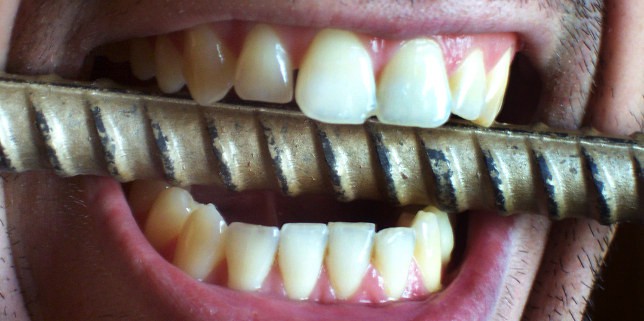When teeth first come into the mouth, they are in pristine condition and come complete with mamelons, remnants of the tooth’s development. Over time, our teeth get worn down. Some people wear their teeth down more than others.
There are four main ways that we wear down our teeth: Abrasion, Attrition, Erosion, and Abfraction. If you’re not sure what those words mean, keep reading and I’ll explain! The man in the picture below is wearing down his teeth in one of those four ways.

Abrasion
Abrasion happens when objects come into contact with our teeth that mechanically wear them away. A common way people wear away teeth is by using their teeth as tools, like chewing through tags on clothes or using your teeth to open packages. Some other examples of abrasion are:
- When you brush your teeth, the grit in the toothpaste can slowly wear away tooth structure. Under normal circumstances, this won’t wear away enough tooth structure to be noticeable, but some people who brush their teeth a LOT will wear away a noticeable amount of tooth structure. This is one of the reasons that our teeth get more yellow as we get older, we are slowly wearing away the enamel and seeing the yellow dentin underneath.
- Chewing on pencils or any other foreign object.
- Chewing on food.
- Chewing tobacco.
Attrition
Attrition is defined as wearing away tooth structure from tooth-to-tooth contact. Some attrition is normal, it’s how mamelons get worn away. Attrition gets to be a problem if you are routinely clenching and grinding your teeth. Many people grind their teeth at night, often without being aware. We make night guards at our dental school which people can wear to prevent them from grinding their teeth at night. If you grind your teeth, talk to your dentist about getting a night guard.
In Peter Dawson’s book Functional Occlusion he states, “When wear penetrates enamel into softer dentin, wear increases seven times faster.” That means that it’s best to get your grinding problem taken care of as soon as possible, because it will only get worse once you grind through the enamel.
Erosion
Erosion occurs when you eat or drink acidic beverages. The reason we get cavities is because plaque living on our teeth produce acid that over time can dissolve our teeth.
Any time acid comes into contact with our teeth, it can dissolve the crystals that make up our teeth. Here are some ways that acid comes into contact with our teeth:
- Eating or drinking acid-containing foods and beverages. If you’re interested in some related reading, here’s 9 drinks that can dissolve your teeth, and a guide to identifying acids in foods.
- When we throw up, either from the flu or from an eating disorder such as bulimia, the acidic contents of the stomach wash over our teeth and slowly dissolve them.
- If you have gastroesophageal reflux disease (commonly known as GERD), your mouth will become acidic due to the acids from the stomach making their way back into your mouth.
- Putting acidic pills or medications in your mouth. Some people suck on vitamin C tablets. Others try to put aspirin on a toothache to make it feel better. Both of these pills are acidic and can cause tooth erosion.
Abfraction
Abfraction is wear at the gumline that has a controversial origin. Some dental experts say that it comes from stress on the tooth when biting and others say that it comes from abrasion due to the grit found in toothpaste. In Dawson’s book mentioned above he says, “What we have been calling abfraction lesions are really the result of toothpaste abuse.”
Abfraction lesions are wedge-shaped and usually appear on the cheek/lip side of the teeth. The book Oral and Maxillofacial Pathology by Neville describes abfraction lesions as “defects that are deep, narrow, and v-shaped…often affect[ing] a single tooth with adjacent unaffected teeth. In addition, occasional lesions are subgingival, a site typically protected from abrasion and erosion.”
Conclusion
As you can see, there are many ways that we wear away our teeth. Many of the causes of excessive wear — consuming acidic foods and drinks, using our teeth inappropriately, and using abrasive toothpastes — are preventable. Even attrition, which results from grinding your teeth, is easily treated by your dentist. Hopefully, you can take steps to reduce the wear on your teeth now that you are aware of the causes.
If you have any questions or comments, please leave them in the comments section below. Thanks for reading!
Oh, and if you’re wondering how the man in the photo above is wearing away his teeth… it’s by abrasion!

Tom,
Great article! I will schedule this with Hoot Suite to post to my Facebook page!